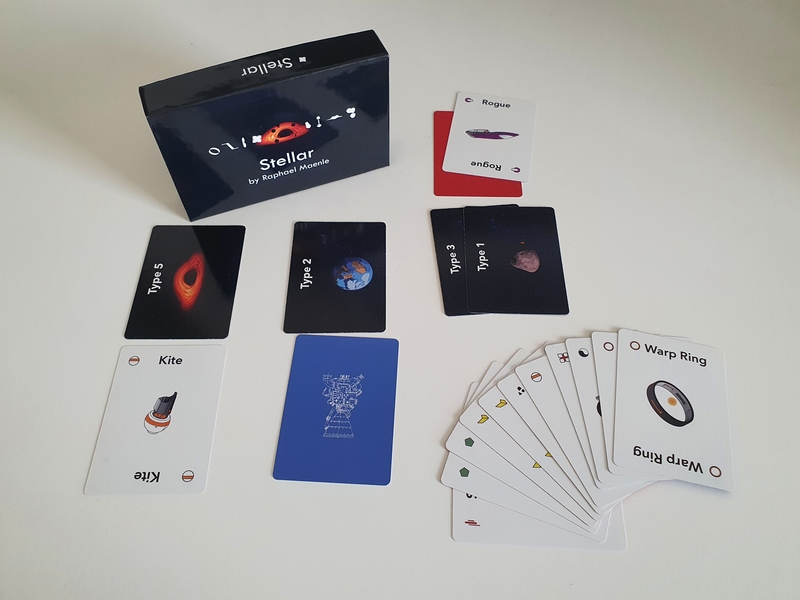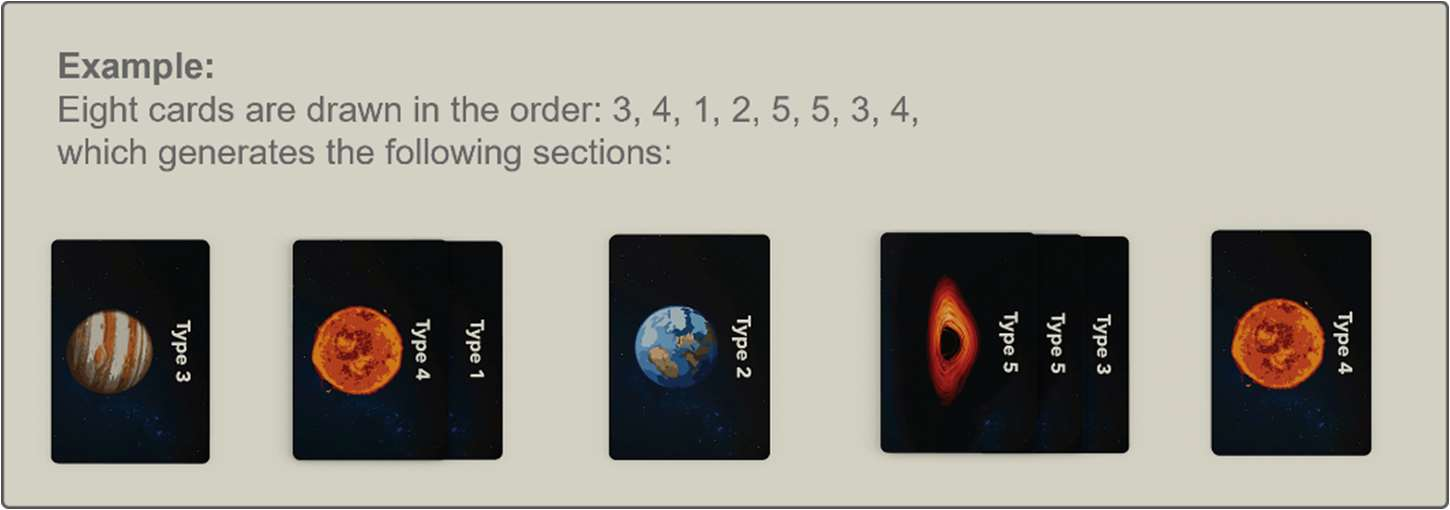
Creating a card game
I’m very excited to announce Stellar, my newest card game. It’s a micro deck-builder where you use your space ships to take control of sectors of solar systems. It’s for two to four players and takes around 20 minutes to play. And you can play it via a tabletop simulator save or, if you’re so inclined, you can buy your very own copy right now.
The rules are available in English and German if you want to read up on the details. Understanding the game shouldn’t take more than 10-15 minutes, though it helps if you have the game in front of you.
In this blog post I’ll give a summary of the games mechanics and go through some of the design process and the decisions I made over the course of the game. I’ll also walk trough how I structured the rulebook.
A summary of the game
At the beginning of each round a new Solar System is randomly created. Every player starts with 16 ships and selects 6 of them for their fleet. You use that fleet to take over as much as you can of the solar system in front of you. If ships are destroyed or you used them to collect a part of the solar system, you can’t use them in the upcoming rounds anymore.
The Planets, Asteroids and Stars that you’re fighting over give you points. At the end of the game, these points are tallied up to find out who won this Stellar war.
Designing the Game
Building a minimal setup
Before I begin to fully form a game, I feel it’s important to define the core mechanics. They don’t have to be a fully working game themselves, but these mechanics should be good enough to provide some excitement.
The first idea for this game was the solar system generation process. In short how it works is, you pull cards from the solar system deck and cluster cards that are descending. If you draw a card with a higher type than the last one, you start a new cluster. I’ve had that process laying around for a few years and I finally wanted to formulate it into an actual game.

Since we’re talking about solar systems here, spaceships made sense thematically. Ship interaction started very low-scale. There were five different ships, three of which were rock-paper-scissors fighting ships. All three could be destroyed by a ‘destroyer’ which itself can be destroyed by the weakest ship, that the rock-paper-scissors ships win against. Basically rock-paper-scissors within rock-paper-scissors.
The players would get one of each ship and place them at a cluster face down. If two ships are at the same cluster, they are revealed and the loosing ship is destroyed. This seemed like the most natural way to interact with the cards I had created.
I’ll admit, this doesn’t sound unbelievably exciting. And it’s not if you’re playing 3-4 rounds in a row. But playing a few rounds with my patient friends showed enough promise, that I decided to develop these core mechanics further into something resembling a more complete functional game.
Adding and Chipping Away
Designing board games is always about managing complexity. It’s fairly easy to think of 10 different action ships and a variety of special solar system cards that all make the game more exciting and varied. But it’s unbelievably hard to find actions that are easy to understand for new players, don’t break anything down the line and fit well with the other components.
But for me at least that’s the process. I build a minimal setup, I go wild with ideas, throw everything I can think of into the game and play a few rounds with it. Some things stick, some things don’t. You break the game and you find some new mechanics that might work well in a different game.
I won’t go through the variations that Stellar went through here, mostly because it’s boring but also because I don’t document every variation I try. But after a few cycles of adding and pruning, the game (hopefully) comes into a state, where it makes sense to test it with a wider audience. This is where entirely new game-breaking problems arise that you hadn’t thought of before. This is also the first time I actually formulate rules for the game, so that other people can test the game without me supervising - “actually” playing the game.
Writing Rules
Writing rules sucks. I find it extremely difficult to explain concepts to people. And apparently so do many other people, because there are a lot of great games out there that have really complicated rule-books.
It helps that Stellar is a rather simple game with few components. The first information to give is usually a summary of the game, so the reader has a rough idea of what’s going to happen. It should be devoid of any game-specific terminology but (in my opinion) can be based on the assumption, that the reader has played games before and knows what a deck-building game is or how rounds work in a game. Basically it should follow the same structure as an elevator pitch or an abstract.
With the general concept out of the way - after which the reader typically is still pretty confused - I try to communicate the elements before them in the game box. With Stellar that’s the various cards. Without going into too much detail, I explain that there are military ships and civilian ships and that the Solar System cards have a Type and hidden points.
Next up, core game mechanics. The building of the solar system is explained (with an example) and building a fleet from all the ship cards (also with an example). The name cards that signify the three stacks of cards, Fleet, Reserve and Settled were added late in the process, because a few of the test players kept getting lost in what cards go where. And adding the placeholder cards really helped to smooth that over.

With this out of the way, the game is ‘set up’ and ready to play.
Explaining the rest of the mechanics was fairly straight-forward. I hope the readers of the rules come away with the same thing. Having a cheat-sheet really helps for new players to get a hang of the game’s structure. The first draft of the rules had quite a few problems, one of them was too many forward references. That happens a lot if you’re giving an overview of a system in the beginning and the way I tried to overcome this is by increasing the detail of the summary to satisfy the primary questions that might come up.
Testing the Game
As I’ve said before, a lot of the play-testing was done by myself and with a very select group of people in the beginning - mainly over tabletop simulator. This allowed me to quickly grasp the fun parts of the game and possibly change the rules as we were going along.
Only after I’d written an initial rule book for reference, did I start testing on a broader set of people. And this very soon lead into testing the game without me assisting in rule understanding and then without me actually being present for some playtests. Many of these tests lead to me pruning the rules a lot. The civilian’s actions were too expansive, the card management too complicated. This also reduced the number of cards overall, so the game was more manageable to shuffle and deal with.

I’m glad that there are so many people that assist in these test rounds - especially since most of the games they get to play have barely functional rules and typically aren’t polished in any way.
Playing the Game
If you want to test the game and you’ve got tabletop simulator - you’re in luck. Just download this game save, load it following this tutorial and start it up. If you want to play the game (and not use generic playing cards to build a poor-mans version of it), the game crafter makes it possible to buy single-run productions of games. You can do so here.